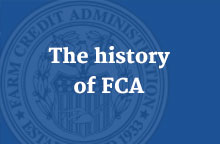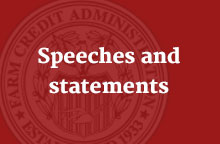Glossary
A
Agricultural Credit Association (ACA)—An ACA results from the merger of a Federal Land Bank Association or an FLCA and a PCA, and has the combined authority of the two institutions. An ACA borrows funds from an FCB or ACB to provide short-, intermediate-, and long-term credit to farmers, ranchers, and producers and harvesters of aquatic products. It also makes loans to these borrowers for certain processing and marketing activities, to rural residents for housing, and to certain farm-related businesses.
Agricultural Credit Bank (ACB)—An ACB results from the merger of an FCB and a Bank for Cooperatives, and has the combined authorities of those two institutions. An ACB is also authorized to finance U.S. agricultural exports and provide international banking services for farmer-owned cooperatives. CoBank is the only ACB in the FCS.
B
Bank for Cooperatives (BC)—A BC provides lending and other financial services to farmer-owned cooperatives, rural utilities (electric and telephone), and rural sewer and water systems. It is also authorized to finance U.S. agricultural exports and provide international banking services for farmer-owned cooperatives. The last remaining BC in the FCS, the St. Paul Bank for Cooperatives, merged with CoBank on July 1, 1999.
F
Farm Credit Act—The Farm Credit Act of 1971, as amended, (12 U.S.C. §§ 2001–2279cc) is the statute under which the FCS operates. The Farm Credit Act recodified all previous acts governing the FCS.
Farm Credit Bank (FCB)—FCBs provide services and funds to local associations that, in turn, lend those funds to farmers, ranchers, producers and harvesters of aquatic products, rural residents for housing, and some agriculture-related businesses. On July 6, 1988, the Federal Land Bank and the Federal Intermediate Credit Bank in 11 of the 12 then-existing Farm Credit districts merged to become FCBs. The mergers were required by the Agricultural Credit Act of 1987. As of September 30, 2004, there were four FCBs: AgFirst Farm Credit Bank; AgriBank, FCB; Farm Credit Bank of Texas; and U.S. AgBank, FCB.
Farm Credit Leasing Services Corporation—The Leasing Corporation is a service entity owned by CoBank, ACB. It provides equipment leasing and related services to eligible borrowers, including agricultural producers, cooperatives, and rural utilities.
Farm Credit System Insurance Corporation (FCSIC)—The FCSIC was established by the Agricultural Credit Act of 1987 as an independent U.S. government-controlled corporation. Its purpose is to ensure the timely payment of principal and interest on insured notes, bonds, and other obligations issued on behalf of FCS banks and to act as conservator or receiver of FCS institutions. The FCA Board serves ex officio as the Board of Directors for FCSIC; however, the Chairman of the FCA Board is not permitted to serve as the Chairman of the FCSIC Board.
Financial Institution Rating System (FIRS)—The FIRS is similar to the Uniform Financial Institutions Rating System used by other Federal banking regulators. However, it has been modified by FCA to reflect the nondepository nature of FCS institutions. The FIRS provides a general framework for assimilating and evaluating all significant financial, asset quality, and management factors to assign a composite rating to each System institution. The ratings are described below.
- Rating 1—Institutions in this group are basically sound in every respect; any negative findings or comments are of a minor nature and are anticipated to be resolved in the normal course of business. Such institutions are well managed, resistant to external economic and financial disturbances, and more capable of withstanding the uncertainties of business conditions than institutions with lower ratings. Each institution in this category exhibits the best performance and risk management practices for its size, complexity, and risk profile. As a result, these institutions give no cause for regulatory concern.
- Rating 2—Institutions in this group are also fundamentally sound but may reflect modest weaknesses correctable in the normal course of business. The nature and severity of deficiencies are not considered material, therefore, such institutions are stable and able to withstand business fluctuations. Overall risk management practices are satisfactory for the size, complexity, and risk profile of each institution in this group. While areas of weakness could develop into conditions of greater concern, regulatory response is limited to the extent that minor adjustments are resolved in the normal course of business and operations continue in a satisfactory manner.
- Rating 3—Institutions in this category exhibit a combination of financial, management, operational, or compliance weaknesses ranging from moderately severe to unsatisfactory. When weaknesses relate to asset quality or financial condition, such institutions may be vulnerable to the onset of adverse business conditions and could easily deteriorate if concerted action is not effective in correcting the areas of weakness. Institutions that are in significant noncompliance with laws and regulations may also be accorded this rating. Risk management practices are less than satisfactory for the size, complexity, and risk profile of each institution in this group. Institutions in this category generally give cause for regulatory concern and require more than normal supervision to address deficiencies. Overall strength and financial capacity, however, still make failure only a remote possibility if corrective actions are implemented.
- Rating 4—Institutions in this group have an immoderate number of serious financial or operating weaknesses. Serious problems or unsafe and unsound conditions exist that are not being satisfactorily addressed or resolved. Unless effective actions are taken to correct these conditions, they are likely to develop into a situation that will impair future viability or constitute a threat to the interests of investors, borrowers, and stockholders. Risk management practices are generally unacceptable for the size, complexity, and risk profile of each institution in this group. A potential for failure is present but is not yet imminent or pronounced. Institutions in this category require close regulatory attention, financial surveillance, and a definitive plan for corrective action.
- Rating 5—This category is reserved for institutions with an extremely high, immediate or near-term probability of failure. The number and severity of weaknesses or unsafe and unsound conditions are so critical as to require urgent external financial assistance. Risk management practices are inadequate for the size, complexity, and risk profile of each institution in this group. In the absence of decisive corrective measures, these institutions will likely require liquidation or some form of emergency assistance, merger, or acquisition.
Federal Agricultural Mortgage Corporation (Farmer Mac)—Farmer Mac was created with the enactment of the Agricultural Credit Act of 1987 to provide a secondary market for agricultural real estate and rural housing mortgage loans.
Federal Farm Credit Banks Funding Corporation—The Funding Corporation, based in Jersey City, New Jersey, manages the sale of Systemwide debt securities to finance the loans made by FCS institutions. It uses a network of bond dealers to market its securities.
Federal Intermediate Credit Bank (FICB)—The Agricultural Credits Act of 1923 provided for the creation of 12 FICBs to discount farmers’ short- and intermediate-term notes made by commercial banks, livestock loan companies, and thrift institutions. The Farm Credit Act of 1933 authorized farmers to organize PCAs, which could discount notes with FICBs. As a result, PCAs became the primary entities for delivery of short- and intermediate-term credit to farmers and ranchers. The FICBs and the Federal Land Banks in all Farm Credit districts have merged to become FCBs or the ACB. Thus, no FICBs remain within the FCS.
Federal Land Bank—The Federal Farm Loan Act of 1916 provided for the establishment of 12 Federal Land Banks to provide long-term mortgage credit to farmers and ranchers, and later to rural home buyers. All Federal Land Banks and FICBs have merged to become FCBs or part of the ACB. Thus, no Federal Land Banks remain.
Federal Land Bank Association—These associations were lending agents for FCBs. Federal Land Bank Associations made and serviced long-term mortgage loans to farmers, ranchers, and rural residents for housing. They did not own loan assets but made loans only on behalf of the FCB with which they were affiliated. As of October 1, 2000, there were no remaining Federal Land Bank Associations serving as lending agents for FCBs.
Federal Land Credit Association (FLCA)—An FLCA is a Federal Land Bank Association that owns its loan assets. An FLCA borrows funds from an FCB to make and service long-term loans to farmers, ranchers, and producers and harvesters of aquatic products. It also makes and services housing loans for rural residents.
G
Government-sponsored enterprise (GSE)—A GSE is a federally chartered corporation that is privately owned, designed to provide a source of credit nationwide, and limited to servicing one economic sector. Each GSE has a public or social purpose: to improve the availability of credit to agriculture, education, or housing. GSEs are usually created because the private markets did not satisfy a purpose that Congress deems worthy—either to fill a credit gap or to enhance competitive behavior in the loan market. Each is given certain features or benefits (called GSE attributes) to allow it to overcome the barriers that prevented purely private markets from developing. In some cases, the GSE receives public assistance only to get started; in other cases, the assistance is ongoing.
P
Participation—A loan participation is a large loan in which two or more lenders share in providing loan funds to a borrower to manage credit risk or overcome a legal lending limit for a single credit. One of the participating lenders originates, services, and documents the loan. Generally, the borrower deals with the institution originating the loan and is not aware of the other participating institutions.
Production Credit Association (PCA)—PCAs are FCS entities that deliver only short- and intermediate-term loans to farmers and ranchers. A PCA borrows money from its FCB to lend to farmers. PCAs also own their loan assets. As of January 1, 2003, all PCAs were eliminated as independent, stand-alone, direct-lender associations. All PCAs are now subsidiaries of ACAs.
S
Syndication—A loan syndication (or “syndicated bank facility”) is a large loan in which a group of banks work together to provide funds for a borrower. Usually one bank takes the lead, acting as an agent for all syndicate members and serving as the focal point between them and the borrower. All syndicate members are known at the outset to the borrower and they each have a contractual interest in the loan.



